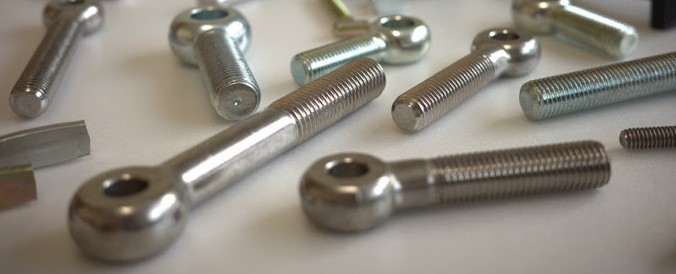Comprehensive Guide to Eyebolts: Structure, Applications, and International Standards
What Are Eyebolts?
Eyebolts, in compliance with international standards, primarily follow DIN 444 (German Standard). Designed for efficient and secure mechanical connections, these fasteners are widely used in load securing and articulated applications. Their most distinguishing feature is the circular eye, allowing integration with hooks, cables, Eye Nuts, and Pins to enhance structural stability and operational safety. This article will provide an in-depth analysis of eyebolts’ structure, material selection, international standards, and proper installation methods to help industrial buyers and procurement professionals select the most suitable product for their applications.

Structure and Types of Eyebolts
DIN 444 Eyebolts (German Standard)
Key Features:
- Forged Construction: Ensures high strength and durability of the eye.
- Long Thread Design: Allows precise tightening and depth adjustment.
- Ideal for Dynamic Connections: Commonly used in hinges, linkages, and mechanical arms.
- Compatible with Eye Nuts & Pins: Enhances stability and load-bearing capacity.
Common Applications:
- Machinery Assembly: Used in bearing housings, motion linkages, and load transfer points.
- Industrial Equipment: Essential for articulations, connections, and fastening in heavy machinery.
- Automotive & Engineering Equipment: Ensures key components are securely fastened and removable when needed.
- Lifting Applications: Used in rigging and securing loads with pins and shackles.
- Pressure Vessels: Applied in securing and suspending components in high-pressure environments.
- Defense Industry: Used in military and aerospace applications requiring high-strength connections.
- Food Industry: Utilized in hygienic and corrosion-resistant fastening solutions.
Standard Sizes: M6 - M36
Strength Grades: 8.8, 10.9 (High-strength alloy steel)
Material Selection & Mechanical Properties
The durability and long-term reliability of eyebolts depend on their manufacturing materials. Below is a comparison of common materials:
| Material |
Corrosion Resistance |
Strength |
Typical Applications |
| Carbon Steel (Gr.2) |
Low (requires galvanization) |
Medium |
General mechanical fastening, low-load applications |
| Alloy Steel (Gr.8) |
Low |
High |
High-load structures, industrial equipment |
| Stainless Steel (304/316) |
High |
Medium |
Marine, outdoor structures, high-humidity environments |
| Galvanized Steel |
Medium |
Medium |
Outdoor construction, transportation infrastructure |
International Standards & Technical Specifications
To ensure safety and reliability, eyebolts must meet strict international standards. The primary specifications include:
- DIN 444 (German Standard): Defines for dimensions, tolerances, mechanical properties, and surface treatment requirements.
Proper Installation & Usage Guidelines
1. Choose the Right Specification
- Select the appropriate thread size, length, and material based on application requirements.
- For high-load applications, opt for DIN 444 Grade 8.8 or higher eyebolts.
- Consider pairing with Eye Nuts and Pins to improve load capacity and connection stability.
2. Ensure Full Thread Engagement
- The minimum insertion depth should be 1.5 times the thread diameter to ensure connection strength.
- Avoid partial threading or excessive tightening, which may lead to material fatigue.
3. Prevent Improper Load Conditions
- Eyebolts are designed to withstand axial loads; lateral forces should be avoided to prevent deformation or failure.
- If side forces are unavoidable, consider using a hinged structure for additional support.
4. Regular Inspection & Maintenance
- Outdoor, high-humidity, or heavy-load applications require periodic checks.
- Look for corrosion, cracks, or material deformation and replace worn-out components to maintain long-term safety.
Why Choose Hung Koon Ltd.?
-
ISO-certified manufacturing ensuring reliable and consistent performance.
-
Custom solutions available to meet specific industry needs.
-
Competitive pricing for bulk orders, helping you lower procurement costs.
For more information or to get a quote, visit our website: Hung Koon Ltd. or contact us at Jasonhuang@hungkoonltd.com.
Conclusion & Recommendations
Eyebolts play a crucial role in machinery, construction, lifting, and fastening applications, especially in high-strength and dynamic connection scenarios. Products that comply with the DIN 444 standard offer superior stability and durability. Additionally, pairing with Eye Nuts and Pins further enhances load-bearing capacity and flexibility, making them ideal for heavy-duty and precision applications.
Choosing the right specifications and materials, while ensuring proper installation, will prolong service life and enhance operational safety. For bulk orders, technical support, or customized solutions, consult a reliable industrial fastener supplier Hungkoon to obtain the best eyebolt solutions tailored to your needs.



